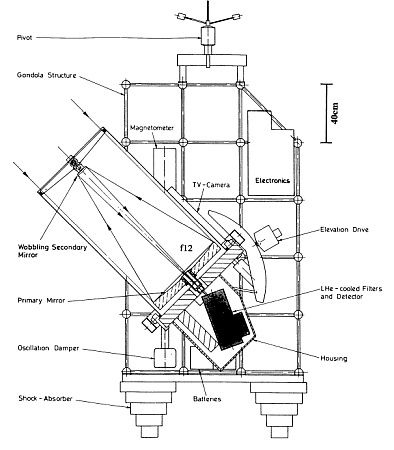Purpose of the flight and payload description
The objective of the flight was to obtain far-infrared imaging of the star-forming region W51A measured at 130 µm and 260 µm wavelength as well as several source parameters of W51-I. The instrument was composed by a 60 cm far-infrared balloon-borne telescope with a liquid-helium cooled photometer attached. A schematic of the complete system is shown at left. The Cassegrain-type telescope with a diffraction limited field of view was previously used in other experiments by the same group for the determination of temperature increases over active regions on the solar disk and the observation of IR sources from Cygnus.
The gondola structure and the telescope stabilization have been designed at the Geneva Observatory. A light-weight telescope frame with a honeycomb instrumental platform and a carbon reinforced plastic telescope tube has been developed at ETH-Zurich in order to reduce the weight of the instrumentation without loss of mechanical stiffness. The fully equipped gondola weighed 470 kg. Its dimensions were 120 cm in length, 170 cm in width and 250 cm in height. Telescope and instruments were protected during ascent and landing with doors and the whole gondola was wrapped in a insulating plastic skin. Coarse pointing with an accuracy of 2 arc min in azimuth was achieved by a magnetometer-controlled pivot, mounted between the gondola and the balloon. An inclinometer provided the coarse position in elevation. Once coarse pointing was accomplished, the star used as guide appeared in the 3° field viewed by a TV camera. The centering on the TV screen bringed the guidance star into the field of view of a star-tracker telescope and finally into its focus under automatic tracking control by a four quadrant fiber-optic and image disector. Reaction wheels whose rotating axes are parallel to the two telescope axes in combination with three gyros prevent the swinging of the gondola during the servo-controlled positioning of the telescope.
The far-infrared section of the gondola consisted of a Cassegrain-type telescope with an attached photometer that served as detector of the incoming far Infra-Red radiation. This radiation was filtered by one of three selectable metal-mesh band-pass filters with central wavelengths centered at about 80 µm, 130 µm and 260 µm. The radiation was detected by a composite silicon bolometer working at a temperature of 1.7º Kelvin during measurements. In order to remove the high offset of the detector signal produced by background radiation from sky, atmosphere, and telescope it wais necessary to chop the signal by beam switching. This switching was achieved by wobbling the secondary mirror in the scan direction at a frequency of 8 Hz. The digitized detector signal together with housekeeping data were transmitted by telemetry to the ground station.
Details of the balloon flight
Balloon launched on: 9/20/1993 at 17:45 utc
Launch site: Centre de Lancement de Ballons CLBA, Aire Sur L'Adour, Landes, France
Balloon launched by: Centre National d'Etudes Spatiales (CNES)
Balloon manufacturer/size/composition: Zero Pressure Balloon Zodiac - 380.000 m3
End of flight (L for landing time, W for last contact, otherwise termination time): 9/21/1993 at 1:30 utc
Balloon flight duration (F: time at float only, otherwise total flight time in d:days / h:hours or m:minutes - ): 7 h 45 m
Landing site: 20 km from Carcassone, France
The balloon flight denominated MIL 1 was performed on the night of September 20/21, 1993. A 380.000 m3 stratospheric hydrogen balloon was used and the mission took place at Aire sur l'Adour, France. Launching took place by auxiliary balloon method at 17:45 UTC. After 3 hours of ascent the balloon reached his final altitude of about 39 km corresponding to an atmospheric pressure of 3.5 mbar. Since the stratospheric winds were strong, the balloon drifted rapidly eastward. At 1:00 UTC the telescope was stowed in vertical position to permit separation of the gondola which was drifting towards the Mediterranean. The gondola landed smoothly half-an-hour later near Limoux, about 20 km from Carcassone. It was recovered and returned to CNES on the same day. No visible damage resulted from the landing, except for the primary mirror, which was wet because of rain.
During this flight, the instrument mapped the continuum emission from W51A at 130 µm and at 260 µm wavelength. Also they succeeded in mapping the dust emission from the HII region-molecular cloud complex W51A at 130 µm and at 260 µm. In order to perform instrumental and radiometric calibration in-flight was also observed Saturn at those wavelengths. On the basis of these measurements, were determined several source parameters of W51-1, such as the color temperature, the hydrogen mass and the total infrared luminosity. In addition, were studied the emission spectrum, the surface brightness, the column density and the temperature distribution.
External references
- Far-infrared Imaging of the HII Region-Molecular Cloud Complex W51A with a Balloon-borne Telescope In: Chiao, R.Y. (eds) Amazing Light. Springer, New York, NY
16155If you consider this website interesting or useful, you can help me to keep it up and running with a small donation to cover the operational costs. Just the equivalent of the price of a cup of coffee helps a lot.


